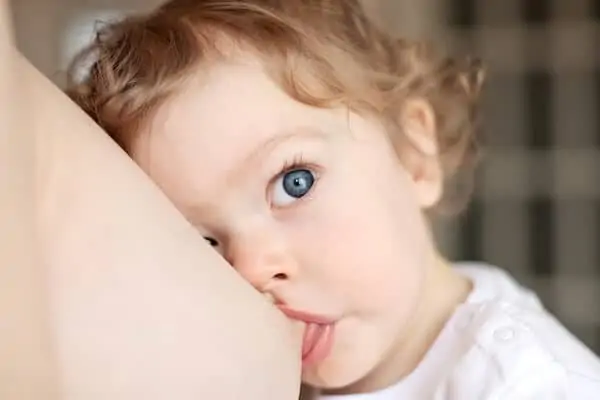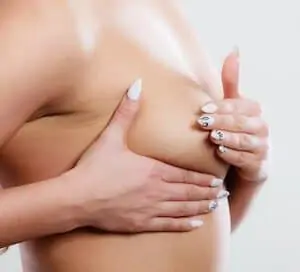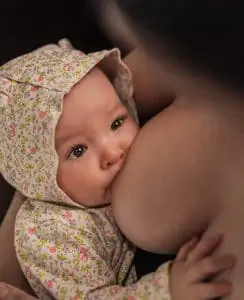Of all the changes I went through from pregnancy to postpartum, the one thing my husband noticed was the boost in boobs that I gained. Granted, much of it was milk. And while I was finally happy to have a bigger chest, I was burdened by it.
Now I knew why my friend Larissa, my chesty friend in college, was always lamenting about her big breasts as though they were a curse. My back ached from carrying them and my eldest around.
That wasn’t the only change, though. There were many more. Some of these changes began when I was pregnant, while others happened after having my first baby. And some of them returned to normal after I stopped breastfeeding, while others did not.
Your breasts have some pretty magical powers, though, and as much as men like to think of them as sexual playthings, they are there for a cool purpose…to feed your baby.
So do your breasts go back to normal after pregnancy?
Well, that all depends. Keep reading to discover what changes you will likely encounter and what they hold for you!
Larger Breast Size
Pregnancy hormones can give you the full breasts you’ve always wanted without a boob job. I had small breasts until I had kids, so I was pretty happy with this new development. But other friends of mine? They were like, “Make it stop!”

In hindsight, I should’ve known I was pregnant with my eldest, thanks to my breasts. Yes, there was the tomato incident (you can read about that here), but I remember that around that time, I’d gotten ready to go for a jog, and as I put on my sports bra, it felt really snug.
This seemed odd because I was exercising all the time and eating properly. And days before, it hadn’t been a problem. But now? I felt like they were swollen. I chalked it up to funky period symptoms and thought that perhaps living abroad had started to make me insane. I’d soon learn I was pregnant and about to get even bigger boobs!
Note that...
Hormones are getting your breasts ready to nourish your baby after you give birth, and during breastfeeding, especially in the beginning, you will have a huge rack. You can’t do anything about those hormones, but one thing that can help is watching your weight.
If you were on the heavy side pre-pregnancy and gained a bit more during it, losing weight may take off some of your unwanted breast heft.
Eventually, even if you keep nursing your baby beyond the age of 1 or 2, your breasts will go down to a more manageable size.
Now that I am all done breastfeeding, my breasts went down a size but are still more prominent than before I had kids, so I’m pretty happy with the results.
Tenderness and Discomfort
Another breast change that begins early on in the first trimester is tenderness. As I mentioned above, something felt different about my breasts that I couldn’t place. They seemed larger than they had only days before and also felt unusual.
The tender feeling I had didn’t alert me, even though this is one of the earliest symptoms women experience, says the National Institute of Child Health and Human Development. The reason it didn’t put me on notice? My breasts would be more sensitive during all my periods than other times during the month.
I merely thought my period was coming on. Until I checked the calendar a few days later. Then I had that “uh-oh” moment.
This breast change tends to come and go, though I found it not to be a problem once I was breastfeeding. Other friends of mine reported it was a constant problem. If you’re worried, just talk to your doctor about it. You should carry on with your breast self-exams while pregnant and nursing. I’ll talk about that more in a moment.
Blue Veins
Remember having beautiful, perfect breasts? And then suddenly, in your first trimester, there’s this big blue vein there. Ugh!
It’s still noticeable for mine though not nearly as much. But it was not like this before I got pregnant. You’ll see this happen because your blood volume increases as much as 50% during pregnancy. These slightly prominent blue veins may even appear on your stomach.
Darker Nipples and Areolas
I was just talking about the changes to your nipples, so you can head over there for the full report, but the short version is that your nipples and the surrounding areola will get darker during the second trimester onward. They will turn back to a normal color later on.
What’s cool is that it’s believed that the hormones in your body do this to help newborns find the nipples because their eyesight isn’t perfect initially. They can’t see well beyond 10 inches away.
Check out my other post about nipples because I discuss some must-know items like those bumps on your areolas and nipple leakage, all things you may encounter as early as the second trimester and onward.
Lumps in Breasts During Pregnancy
Lumpy breasts are enough to scare anyone. They are uncommon during pregnancy, usually starting around the second trimester. Most lumps during pregnancy aren’t anything to worry about. Sometimes, it’s merely clogged milk ducts (known as galactoceles) or benign breast tumors (called fibroadenomas).

Breast cancer risks during pregnancy are incredibly low, especially if you are under 35. But don’t assume you’re all clear, either. Please keep conducting your breast self-exams. Your doctor will also check them during your prenatal visits (post-natal too).
This very informative guide from the National Cancer Institute can give you more information on what to look for. Because of the changes in your breasts during pregnancy, it can be harder to diagnose breast cancer. Yes, it’s rare, but it happens, and being vigilant will help you catch anything wrong in enough time.
They say women that breastfeed are less likely to get breast cancer. This should be good news, but I’d like to tell you about my dear friend Adele who passed away two years ago. We were friends since college. She was one of the kindest people I’d ever met.
We always kept in touch, and when I moved abroad, she’d call me on Skype to talk. Then one day, she called me to tell me she had breast cancer. She had breastfed her daughter and was a good person! This wasn’t supposed to happen to her.
But it did. And she beat it. She kicked cancer’s butt and came out on top. She was cancer-free for about two years. By this time, I was back in America. And, like always, we stayed in touch. She called me one day and told me she was sorry she hadn’t been in touch (I’d sent her some texts and left a few messages). She said she’d been feeling very sick.
She went to the hospital, and they found cancer had come back and was now in her lungs. I prayed she’d be ok, but it didn’t sound right. I kept in contact with her weekly until she went into the hospital one last time. She went out a fighter.
Her husband called me at 5 am a few days later and told me she was gone :(. I will never get over her. I will never get over that just a month before she’d been diagnosed with breast cancer, she had gone for her yearly appointment at her gynecologist and had a breast exam. Nothing was wrong then.
She did her self-exam the next month and found the lump.
I’m crying right now as I write this, and I hope you’ll forgive me, and I’m not trying to frighten you, but please, oh please, check yourself out
Stretch Marks
Now for something a little less serious. Stretch marks. These occur when you experience rapid growth or weight loss (like in puberty) and can happen on your breasts or belly.
My friend Carol was an itty-bitty thing before her first baby. All that stretching on her belly gave her visible stretch marks. She never used any creams, oils, or lotions, so they never faded away. So that you know, using those stretch mark lotions to prevent them may not completely stop them, but it will make them much less noticeable and help you fade them after pregnancy when you lose the baby weight.
You should slather these things on to help, or else you can count on always wearing a one-piece to the beach like Carol.
Breast Sagging
Contrary to popular belief, breastfeeding doesn’t cause breasts to sag. It’s those dang pregnancy hormones once again. You can try to counter it by maintaining a stable weight and wearing the right bra (more on bras coming up shortly).
Heredity and the size your breasts grew to during pregnancy also play a role in saggy breasts. You can tighten the skin on your breasts, but that won’t stop the sagging. It will just get your skin in excellent condition. You can ease their appearance by working your chest muscles behind your breasts, but it won’t stop the sag.
You might be stuck with saggy boobs, my friend, but thankfully, you can wear the right bra or even consider augmentation if you’d prefer. My friend Michelle went and did that after having her third (and last, as she declared) child, and she is thrilled.
Achy Breaky Breasts
Once breastfeeding, you may feel a bit of an ache in your breasts. Most of the time, this is nothing to freak out about. It usually means your breasts are engorged with milk, and you must let some of it out. Have the baby help you by breastfeeding, but if the baby is full and your milk is still overflowing, now is a great time to grab that breast pump.
You can also find relief in ice packs or cabbage. Yes, cabbage. I talk about that here.
Choosing the Right Bra Helps
If you’re just now pregnant, you’ve probably figured out pretty quickly that your bras aren’t going to cut it anymore. Living in Asia, finding a regular bra to fit me before pregnancy was impossible, and I had a B-cup! Everything was tiny, so finding one for a bustier me was almost impossible until I enlisted my Asian girlfriends to help me shop.
When shopping for new bras during this new phase in your life, you’ll want to tuck away any with underwire bras until long after you’re done breastfeeding.
Fair warning:
You may throw them out when all is said and done because your boobs won’t fit anymore if they stay larger.
Underwires can obstruct your milk ducts and cause problems in milk production. Not to worry, though! They make some tremendous wire-free bras that provide exceptional support and comfort.
How to Choose a Bra for Your Pregnant or Breastfeeding Boobs?
Aside from no underwire, you should look for a bra that:
- Provides good support
- Has wide straps
- Is easy to adjust to the closures
- Is made from breathable cotton
- Has no seams near the nipple area
Another option I used until I found a proper bra is to wear sports bras. My friend Laci swore by her sleep bras.
You might want to buy nursing bras once you have the baby. Some women buy them while they’re still pregnant. I advise against this. That’s because my boobs increased once my milk fully came in. They were enormous! Nothing I would have picked would have fit me.
Nursing bras are not a necessity, though. You can flip the bottom of a bra or sports bra up if you need to.
Another recommendation from my friend Angelica: get a professional fitting for your bras. I didn’t have this option being abroad, but if I did, that would have been a blessing!
Final Breast Change Thoughts
So basically, some of you will have these breast changes start early in your pregnancy, while others won’t. Some of you will have these changes return to normal afterward, while others won’t. It’s all due to your crazy hormones and an increase of blood in your body, though some things are hereditary, and that’s really that.
Even if some things don’t go back to normal, that’s okay. Because what is “normal” anyway, especially when you have a baby in the house? I can assure you that nothing will be normal once you become a mom, and I know you’ll be quite alright with that!
Leslie Berry lives with her husband and two young daughters in Los Altos, California, where she loves helping other moms get comfortable with motherhood and embracing the insanity with facts peppered with laughs.
She loves eating too much sushi, exercising, and jamming out on her Fender. Read more about Leslie here.




